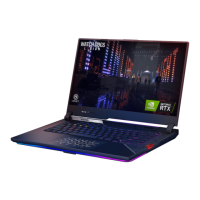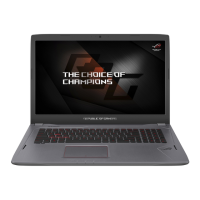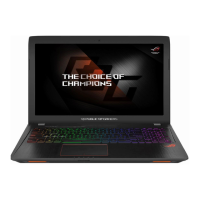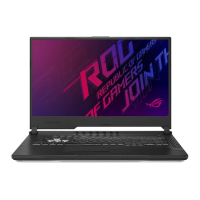Do you have a question about the Asus ROG STRIX G733Z and is the answer not in the manual?
Details the hardware components of your Notebook PC.
Shows how to use the different parts of your Notebook PC.
Provides an overview of using Windows in your Notebook PC.
Shows how to use POST to change settings.
Presents recommended tips, hardware, and software FAQs.
Includes notices and safety statements for your Notebook PC.
Highlights key information using IMPORTANT!, NOTE:, and WARNING! messages.
Explains icons indicating devices used for tasks.
Defines bold and italic text usage for menus and references.
Specifies recommended ambient temperatures for operation.
Caution regarding heat buildup and blocking vents.
Warning against using damaged power cords or accessories.
Guidelines for in-flight usage and airline policies.
Instructions for cleaning and avoiding liquid damage.
Avoid strong solvents and placing objects on the PC.
Avoid strong magnetic fields, liquids, rain, moisture, and dust.
Do not dispose in municipal waste; recycle responsibly.
Do not discard batteries in municipal waste.
Avoid gas leaks, electromagnetic interference, and mining.
Charging under high voltage shortens battery life.
High temperatures damage battery capacity and life.
Normal capacity drop when device is powered off.
Charge battery to 50% for long periods of inactivity.
Discharge battery to 50% periodically if using AC power.
Store in moderate temperatures and dry environments.
Introduction to the notebook's hardware components.
Identifies components visible with the display panel open.
Identifies components visible with the display panel closed.
Details the components located on the bottom of the PC.
Identifies ports and vents on the sides and rear.
Step-by-step instructions for replacing the armor cap.
Instructions for initial charging and power adapter details.
Steps for opening the display and pressing the power button.
Guide to touchpad gestures and pointer movement.
Details on function keys, Windows keys, and numeric keypad.
Guide for starting and configuring Windows for the first time.
How to use the Start menu for programs and settings.
Managing Windows apps, pinning, and unpinning.
Switching between apps, desktops, and accessing widgets.
Arranging apps side-by-side and managing notifications.
Optimizing OLED display with Dark Mode and brightness.
Common shortcuts for launching applications and navigation.
Instructions for connecting to Wi-Fi, Bluetooth, and wired networks.
Procedures for turning off and putting the PC to sleep.
Understanding POST and accessing BIOS settings.
Procedures for restoring or refreshing the system.
Steps to access and use system recovery options.
Maximizing performance, security, and data backup.
Answers to common hardware-related questions.
Answers to common software-related questions.
Includes CTR 21, FCC, and ISED compliance information.
Covers UL safety, power requirements, and battery cautions.
Details on REACH, RoHS, and environmental regulations.
Information on ASUS recycling, battery recycling, and regional notices.
Details the hardware components of your Notebook PC.
Shows how to use the different parts of your Notebook PC.
Provides an overview of using Windows in your Notebook PC.
Shows how to use POST to change settings.
Presents recommended tips, hardware, and software FAQs.
Includes notices and safety statements for your Notebook PC.
Highlights key information using IMPORTANT!, NOTE:, and WARNING! messages.
Explains icons indicating devices used for tasks.
Defines bold and italic text usage for menus and references.
Specifies recommended ambient temperatures for operation.
Caution regarding heat buildup and blocking vents.
Warning against using damaged power cords or accessories.
Guidelines for in-flight usage and airline policies.
Instructions for cleaning and avoiding liquid damage.
Avoid strong solvents and placing objects on the PC.
Avoid strong magnetic fields, liquids, rain, moisture, and dust.
Do not dispose in municipal waste; recycle responsibly.
Do not discard batteries in municipal waste.
Avoid gas leaks, electromagnetic interference, and mining.
Charging under high voltage shortens battery life.
High temperatures damage battery capacity and life.
Normal capacity drop when device is powered off.
Charge battery to 50% for long periods of inactivity.
Discharge battery to 50% periodically if using AC power.
Store in moderate temperatures and dry environments.
Introduction to the notebook's hardware components.
Identifies components visible with the display panel open.
Identifies components visible with the display panel closed.
Details the components located on the bottom of the PC.
Identifies ports and vents on the sides and rear.
Step-by-step instructions for replacing the armor cap.
Instructions for initial charging and power adapter details.
Steps for opening the display and pressing the power button.
Guide to touchpad gestures and pointer movement.
Details on function keys, Windows keys, and numeric keypad.
Guide for starting and configuring Windows for the first time.
How to use the Start menu for programs and settings.
Managing Windows apps, pinning, and unpinning.
Switching between apps, desktops, and accessing widgets.
Arranging apps side-by-side and managing notifications.
Optimizing OLED display with Dark Mode and brightness.
Common shortcuts for launching applications and navigation.
Instructions for connecting to Wi-Fi, Bluetooth, and wired networks.
Procedures for turning off and putting the PC to sleep.
Understanding POST and accessing BIOS settings.
Procedures for restoring or refreshing the system.
Steps to access and use system recovery options.
Maximizing performance, security, and data backup.
Answers to common hardware-related questions.
Answers to common software-related questions.
Includes CTR 21, FCC, and ISED compliance information.
Covers UL safety, power requirements, and battery cautions.
Details on REACH, RoHS, and environmental regulations.
Information on ASUS recycling, battery recycling, and regional notices.











